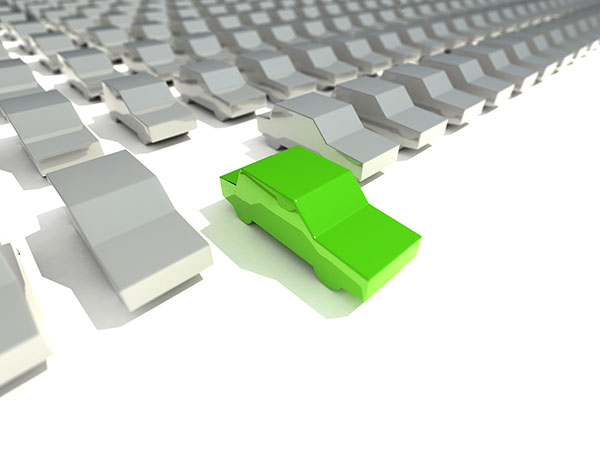Intro to "When is it Profitable to End a Car Lease or Loan Contract Agreement?"
Try the calculator When is it Profitable to End a Car Lease or Loan Contract Agreement? >
Calculate the Depreciation of a Vehicle vs. its Outstanding Balance
A vehicle depreciates in a non linear trend during its term, unlike the outstanding balance, and there is always a risk when leasing or financing that the vehicle value will be lower than its book value, i.e. the market value of the automobile or the truck would be less than the balance left to be paid on the contract, a situation also known as negative equity.
If you lease or finance a car and plan to buy it out from the dealership or the financial institution, before the end of the term, you are running the risk of concluding a transaction in a negative equity position. Consequently, the early buyout will be more expensive than purchasing the same vehicle in identical conditions on the market. Because of the car's convexed depreciation curve, you are more exposed to that problem at beginning of the term.
Car and Truck Depreciation
 In general, on the first year, the loss of value of a new car or truck ranges between 20% and 40% of the manufacturer's suggested retail price (MSRP). The following years, it loses on average 15% to 25% of the previous year value.
In general, on the first year, the loss of value of a new car or truck ranges between 20% and 40% of the manufacturer's suggested retail price (MSRP). The following years, it loses on average 15% to 25% of the previous year value.
Some makes and models devaluate faster than others and the price of a used car or truck drops considerably when a newer version comes out. You also have to add the odometer and the wear and tear damages as factors influencing the value.
In the case of a lease, the outstanding balance can take up to the last payments to reach the vehicle's market value, depending on the term of the agreement, the lease-end residual value and the depreciation rate.
Going from Negative Equity to Positive Equity
When the outstanding balance on the vehicle is higher than its market value, buying the car from its owner to sell it after won't be profitable. The car's value wouldn't be enough to cover the early buyout cost. But when the book value crosses with its market value, we are reaching the point of profitability, and this positive equity will not reverse when reached after the first two years.
Indeed, it is unlikely to lose the positive equity when obtained after the first two years, because at this point the value of the vehicle decreases more slowly than the outstanding balance with regular monthly payments. The market value of the vehicle will then cover the balance left to be paid if there is a resell, and could even make a profit.
The Two Curves
The dangerous moment to terminate a contract agreement is mostly at the beginning of the term, since the vehicle's value decreases at a much faster pace than its outstanding balance in the first two years. By exposing the depreciation and outstanding balance curves in time with a chart, we can observe that the outstanding balance is linear while the car's value is convex, following a devaluation rate proportional to the previous year value. If there is no down payment, the two curves cross only after two years.
The gap between the two curves is even bigger in case of leasing, because the residual value will not let the outstanding balance decrease too rapidly. Moreover, in early lease buyout, the taxes might be applicable on the outstanding balance, depending on the contract's jurisdiction. If the sale taxes are applicable, it will increase the buyout cost, causing a larger difference between the book value and the market value of the vehicle.
Two Forms of Down Payments; Capitalized Cost Reduction and Security Deposit
The capitalized cost reduction, which is a down payment applied upfront on the outstanding balance, is amortized during the whole term; it decreases the monthly payment and the interest paid. Also, by lowering the balance left to be paid, it improves the borrower's equity position. Some financial institutions, however, require a security deposit instead, which is another way to put money down when leasing, but it does not have the same impact.
The security deposit is given to the lessor in the beginning and returned to the lessee at the end of the term. It is simply an amount put aside in case of default, without even generating interest income for the lessee. Consequently the monthly payments, the interest costs and the equity position will stay the same. The only advantage for the lessee is when there is an offer to lower the interest rate in exchange for a good security deposit, in this case, the security deposit could be an attractive proposition, otherwise, it should be avoided.
When is the Best Time to Terminate the Contract Agreement?
In order to obtain the maximum profit on a resell, if there is no substantial cash down, the best course of action is to wait for the end of the term, and even there, it is not always possible to make a profit when leasing (you can verify by calculating your lease-end options). However, once the positive equity is reached after the first two years, there is always a way to make a profit before the end of the term, because at this point every payment made on the balance increases the profit on an eventual resell, since the depreciation decreases more slowly than the outstanding balance.
With the following calculator, you can simulate and compare the car's devaluation with its book value by specifying the contract agreement's term and the vehicle depreciation rate. This will provide you the potential approximate gain or loss you risk to get if you plan to buy the vehicle early and resell it before the end of the term.
Try the calculator When is it Profitable to End a Car Lease or Loan Contract Agreement? >




